Weatherz School: Understanding normal
When you hear the word “normal” you might think of it as describing something that is typical or ordinary.
For example, one could say Chief Meteorologist Justin Liles is not normal. But we can’t think of “normal” the same way when referring to the weather.
Normal temperatures and precipitation don’t represent the average going back to the 1870s, when we first started keeping record. They’re the average weather conditions over a set 30-year range.
Right now, the normal period is 1991-2020. That will be the case for another seven years, then normal will be the average for 2001 to 2030.
Climate normals give us a reference point for describing our weather as warm or cold, wet or dry, or run of the mill. It’s true that it’s “normal” for the weather we experience to swing above and below average.
We expect Duluth to have at least one summer day with 90° heat, and most every winter brings a blast of Arctic air at some point.
Even so, when Duluth stayed below zero on January 15th, it was more than 20 degrees colder than normal based on the 30-year average.
Let’s look at how Duluth’s normal has changed since the 1951-1980 period starting with the mean annual temperature.

Each period was warmer than the one before it at a steady rate with a total rise of two and a half degrees.

Annual precipitation trended up overall with an increase of an inch and a half. We added a full inch from the ’61 to ’90 normal to 71’ to 2000, but we took a slight step back with the ‘81 to 2010 normal.
Snowfall is a little different because they didn’t keep record of official normals for it for the first few periods. Instead, let’s compare the direct averages for consistency. The official normal is close to the mathematical average, but the numbers tend to be slightly different.

For average snowfall, ’61 to ’90 was a hair less than ’51 to ’80, but the rest of the periods have had a strong trend upward with an increase of nearly a foot overall.
So, when meteorologists talk about normal, it takes on a different meaning than in typical conversation. All weather eventually becomes part of the 30-year normal, but the definition of normal evolves with each decade. In general in our region, that evolution has been warmer, wetter, and snowier.